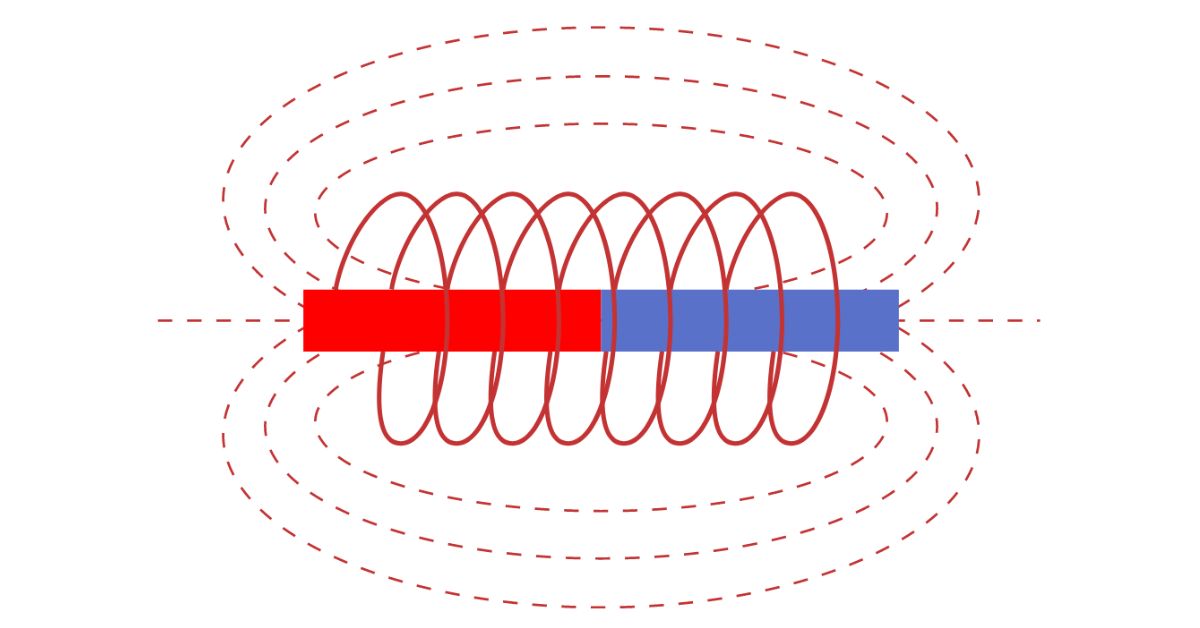What is a magnetic field? This is an important concept in the field of physics and plays a big role in life. This article will help you better understand the concept of magnetic field and how to determine its direction through the right hand rule. This is a simple but effective method for directing magnetic fields in electrical wires and coils.
What is a magnetic field?
Magnetic field is a concept in physics, it describes the space around an object or an electric current that has the ability to affect other charged particles or magnetic objects. Simply put, a magnetic field is the space where magnetic forces can act. For example, the Earth’s magnetic field or the magnetic field of a magnet.
Bạn đang xem: Từ trường là gì? Quy tắc nắm bàn tay phải
Magnetic objects such as magnets or electric current passing through a wire create a magnetic field. Magnetic fields are represented through magnetic field lines with the direction of the field lines depending on the rule of force acting on a charged object, such as an electric current or the magnetic pole of a magnet.
The intensity of the magnetic field is strongest near the source such as the pole of the magnet and gradually weakens as it gets farther away from the source. In physics, magnetic fields are measured in units of Tesla (T) in the international system of measurement (SI). In particular, in today’s life, magnetic fields have many practical applications. From electrical devices such as motors and transformers to medical applications in magnetic resonance imaging (MRI).

What are the characteristics of a magnetic field?
Magnetic fields have the following characteristics to help you easily identify:
Vector quantity
The magnetic field is a vector quantity, which means it is determined by both magnitude and direction. The magnetic field vector B at a particular point not only indicates the strength of the magnetic field but also the direction in which the magnetic force acts on a moving charged particle. This means that when an object is subjected to a magnetic field, its movement will be governed by the direction of the magnetic field vector at that location.

Direction of the magnetic field
What is the direction of the magnetic field? The direction of the magnetic field is determined by the right-hand rule. If you place the thumb of your right hand in the direction of the current flowing through the wire, the remaining fingers will indicate the direction of the magnetic field lines around the wire. Magnetic field lines always point from the North pole to the South pole outside a magnet and vice versa inside the magnet.

Created by moving electrical charges
Magnetic fields are created by the movement of electrical charges. When there is an electric current (i.e. a flow of electrical charges), a magnetic field appears around that current. This is described in Ampere’s law and can be clearly seen in experiments with wires with current flowing through them.

Interaction with electric fields
What is the relationship between electric and magnetic fields? Magnetic fields and electric fields have a close relationship and together form the electromagnetic field. According to Maxwell’s theory, a change in the electric field can create a magnetic field and vice versa.
This is the basic principle behind the phenomena of electromagnetic waves and alternating current. Electric and magnetic fields can not only interact but can also switch back and forth in systems such as coils and capacitors in electrical circuits. Magnetic fields and electric fields are two aspects of the electromagnetic field and their interactions are described through Maxwell’s equations.
The right hand rule relates to magnetic fields
The right-hand rule is an intuitive method for determining the direction of vector quantities in a magnetic field with respect to electric currents and magnetic forces. This rule is used to determine the direction of the magnetic field around a current-flowing conductor.
Hold your right hand so that your thumb points in the direction of the current flowing through the wire. Then, the remaining fingers will indicate the direction of the magnetic field lines surrounding that wire. Magnetic field lines are in the form of concentric circles around the wire and their direction depends on the direction of the current. For example, if current flows vertically from bottom to top, the magnetic field will rotate clockwise when viewed from above.

What is the difference between electric and magnetic fields?
To distinguish magnetic fields and electric fields, we can rely on a number of key factors such as their origin, impact and how they work:
Source
Electric field: Created by electrical charges (stationary or moving). When there is an electric charge at a point in space, it creates a surrounding area of space into which any other charge that enters will experience an electric force.
Magnetic field: Created by moving charges or electric currents. Whenever there is an electric current or a charged particle moves, a magnetic field appears around it.

Impact force
Electric field: exerts force on stationary or moving charges. The electric field is directed from positive charge to negative charge and the electric force is proportional to the magnitude of the charge as well as the electric field.
Magnetic field: What is the force effect of magnetic field? Magnetic fields act on moving electric currents or charges. Magnetic fields do not act on stationary charges but only interact with charged particles as they move, creating a magnetic force perpendicular to the direction of movement.

Line of force
Xem thêm : PTE là gì? Những thông tin bạn nên biết về chứng chỉ PTE
Electric field: Electric field lines originate from positive charge and end at negative charge (in the case of static charge).
Magnetic field: Magnetic field lines form closed loops, originating from the North pole of a magnet and returning to the South pole.

Impact on materials
Electric field: Has an impact on conductive or insulating materials (such as creating polarization in dielectric materials).
Magnetic fields: What is the ability of magnetic fields to affect materials? Magnetic fields mainly act on magnetic materials (such as iron, nickel) or other electric currents and create electromagnetic induction when the magnetic field changes.

Measurement unit
Electric field: Measured in Volts per meter (V/m).
Magnetic field: Magnetic field is measured in Tesla (T) or Gauss (G).

Interaction with charged particles
Electric field: Acts on both static and dynamic charges.
Magnetic field: Acts only on moving charges or electric currents, through the Lorentz force.
The difference between magnetic and electric fields can be clearly seen through many phenomena. For example, magnetic field effects only occur when there is movement of charges, while electric fields can exist around static charges.

What is the application of magnetic fields?
Magnetic fields have many applications in life and technology. Here are some important applications of magnetic fields:
Electric motor
Electric motors are one of the most common applications of magnetic fields. The magnetic field is created by a magnet or coil, which converts electrical energy into mechanical energy. In electric motors, the magnetic field creates torque that rotates the rotor, helping the machine operate.

Generator
Generators use the principle of magnetic induction, in which a changing magnetic field induces an electric current in a coil. This process converts mechanical energy into electrical energy and is the operating principle of generators in power plants.

Electronic equipment
What is the application of magnetic fields? Magnetic fields play an important role in many electronic devices such as speakers, microphones, hard drives, and computers. For example, in a hard drive, magnetic fields are used to store data thanks to their ability to magnetize small areas on the surface of the magnetic platter.

MRI equipment
In medicine, strong magnetic fields are used in magnetic resonance imaging (MRI) devices to create detailed images of the inside of the body. The magnetic field in an MRI machine interacts with hydrogen atoms in the body, allowing the machine to create detailed images of organs and tissues.

Wireless power transmission
What is the application of magnetic fields in wireless power transmission? Wireless charging technology uses magnetic fields to transmit power from the charging station to the device. This method works based on the principle of magnetic induction. In which magnetic fields are used to convert electrical energy over short distances without the need for wires.

Application in transportation
Xem thêm : Cung Mọc là gì? Cách xác định cung Mọc
Magnetic trains (maglev) use magnetic fields to lift and push trains along rails without direct contact. This magnetic field helps reduce friction, allowing ships to move at high speeds and save energy.

Filter water using magnetic field
What is magnetic water filtration? Some water filtration systems today use magnetic fields to reduce dirt and chemical compounds in water. The magnetic field affects the molecular structure of ions in water to help increase the efficiency of the water filtration process.

Compass
The compass is a classic application of magnetic fields. The compass needle always points to magnetic North thanks to its interaction with the Earth’s magnetic field.

Electromagnets in industry
What is the application of magnetic field in electromagnet. Electromagnets are widely used in industry to lift and move heavy metal objects such as steel and iron. This is an effective method for moving materials in warehouses and manufacturing plants.

Protect Earth from radiation
The Earth’s magnetic field forms a protective layer, called the magnetosphere, that helps block cosmic radiation and high-energy particles from the sun. This helps protect organisms on Earth from the harmful effects of radiation.

Applications in science and research
What is the application of magnetic fields in many scientific experiments and research. It is used to test the properties of materials, study elementary particles in physics, and many other fields.

What are some other concepts related to magnetic fields?
In addition to learning about magnetic fields, you can learn a few more concepts related to magnetic fields as follows:
Magnetic field lines
Magnetic field lines are closed curves or endless straight lines that do not intersect in a space containing a magnetic field. Magnetic field lines are drawn to represent the magnetic field and they have some basic properties as follows:
- Always starts from the North pole and ends at the South pole of a magnet.
- These lines never intersect.
- The thicker the density of magnetic field lines, the stronger the magnetic field. Conversely, when the magnetic field lines are sparser, the magnetic field in that region is weaker.
- At every point on a magnetic field line, the magnetic induction vector is tangent to that line.

Magnetic induction
In addition to learning what a magnetic field is, many people also wonder what magnetic induction is? This is a phenomenon of forming an electromotive force (voltage) on a conductor if this conductor is placed in a changing magnetic field.

Uniform magnetic field
A uniform magnetic field is a magnetic field in which, at every point in space, the magnetic induction vectors have the same direction, direction and magnitude. A typical example of a uniform magnetic field is the magnetic field inside a coil (solenoid) when current flows through it. In a uniform magnetic field, the magnetic field lines are parallel and equally spaced.

Earth’s magnetic field
The Earth’s magnetic field is the natural magnetic field created by the Earth’s core, which acts like a giant magnet with magnetic poles. The Earth’s magnetic field plays a role in protecting the planet from high-energy particles from the Sun (solar wind).
The Earth’s magnetic poles do not coincide with the geographical poles. Therefore, they are called the magnetic North pole and the South magnetic pole. Characteristics of the Earth’s magnetic field can change over time, including magnetic pole reversals that occur after thousands to millions of years.

Understanding the concept of what a magnetic field is and how to apply the right hand rule not only makes it easier for you to explain physical phenomena, but also brings many practical applications in life and technology. . From transformers and electric motors to guidance systems, magnetic fields play an indispensable role. It opens the door to modern applications that we use every day.
Refer to related articles:
Nguồn: https://tuyengiaothudo.vn
Danh mục: Hỏi Đáp










